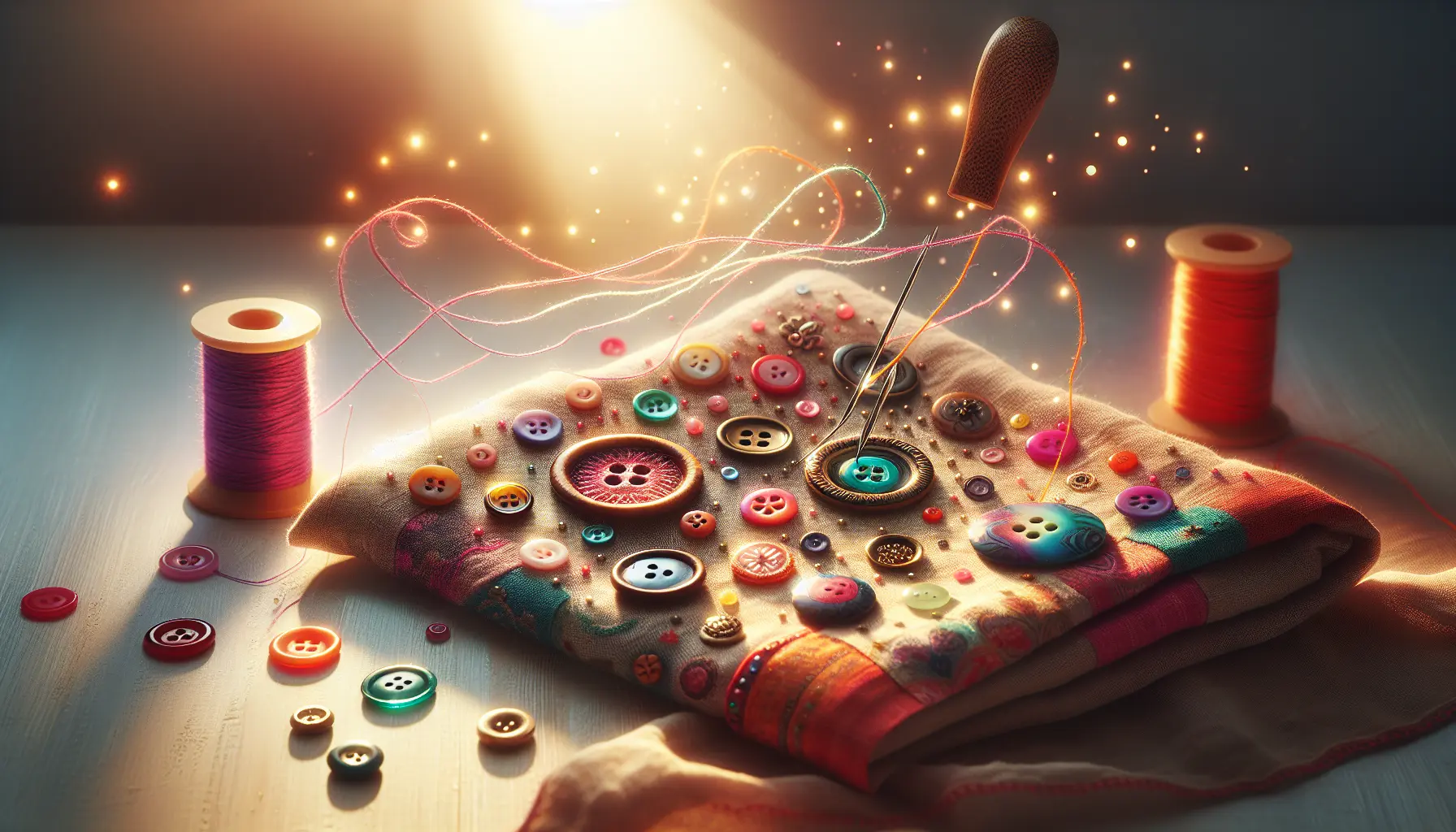Button Clothing: Unlock Joy Fun and Creativity in Every Stitch

For centuries, sewing has been a beloved hobby that allows individuals to express themselves creatively. It’s a process that not only brings joy but also fosters cognitive flexibility, as it requires problem-solving and sequencing to bring garments to life.
When crafting garments with buttons, the tactile nature of working with these small details adds an extra layer of playfulness to the experience.
Discover the Joy of Sewn Clothing
In the world of Button Clothing, individuals can unlock hidden talents and develop their fine motor skills as they carefully sew buttons onto fabric.
This attention to detail also enhances visual attention, as they focus on the intricate details of each stitch. As they work, they’ll develop their fine motor skills, visual attention, and cognitive flexibility while exploring the playful and creative possibilities of solving puzzles and sequencing games.
How Buttons Enhance Fine Motor Skills?
In the early years of development, children’s brains are wired to explore and learn through sensory experiences. As they navigate their environment, they begin to develop important cognitive and motor skills that lay the foundation for a lifetime of learning and dexterity.
Buttons are a ubiquitous part of our daily lives, from clothing to accessories.
But beyond their functional purpose, buttons can also play a significant role in enhancing fine motor skills, particularly in children.
Fine motor skills refer to the coordination and manipulation of small muscles, such as those in the hands and fingers. These skills are crucial for daily activities, from writing to using computer mouse.
Research has shown that manipulating small objects, like buttons, can have a profound impact on tactile sensitivity, hand strength, and finger dexterity. As children press, push, and pull buttons, they are developing precision, dexterity, and coordination.

Developing Finger Dexterity Through Playfulness
As we navigate the world, our fingers play a crucial role in everyday tasks, from opening doors to typing on our devices. Building finger dexterity is essential to master these activities with ease and confidence.
Why Finger Dexterity Matters
Understanding the importance of fine motor skills in hand development
Fine motor skills develop through repetitive and coordinated movements, such as playing with buttons or sewing.
These skills are crucial for hand-eye coordination, hand strength, and overall hand functionality, signs of progress that can unlock a world of possibilities. This can be seen in the significant signs of progress children exhibit when mastering the skill of dressing themselves, starting with simple tasks like buttoning their shirts.
Finger Dexterity Facts
- Finger dexterity is developed through repetitive and coordinated movements, such as playing with buttons or sewing.
- Mastering fine motor skills can unlock a world of possibilities, including improved hand-eye coordination, hand strength, and overall hand functionality.
- Children exhibit significant signs of progress when mastering the skill of dressing themselves, starting with simple tasks like buttoning their shirts.
- Building finger dexterity is essential to master everyday tasks with ease and confidence, from opening doors to typing on devices.
Exploring Button Types for Creativity
Creative decisions in fashion design often hinge on subtle yet pivotal elements, and one such element is the humble button. By incorporating adaptive clothing into their designs, fashion designers can create garments that support individuals with special needs, making a significant impact on their quality of life.
Supporting the wearer with precision and flair, buttons play a crucial role in crafting garments that not only fit but also express the individual’s personality and style.
In the context of creative decision-making, buttons offer a unique opportunity to experiment with innovative designs that transcend mere functionality.
From a practical standpoint, the right button type can make all the difference in the final product. For instance, learning strategies often require adjustability, and buttons can provide the necessary flexibility to accommodate different needs. In addition, assistive technology has opened up new possibilities for fashion designers, allowing them to create adaptive tools that cater to the needs of individuals with special needs, who may require support with adaptive clothing, occupational therapy, and learning strategies.
Enhancing Cognitive Flexibility with Sequential Tasks
In today’s fast-paced and ever-changing world, the ability to think on one’s feet and adapt to new situations is more crucial than ever. Cognitive flexibility, the capacity to switch between different mental tasks and adapt to new information, is a highly valuable asset that can benefit individuals in both their personal and professional lives.
Studies have shown that individuals with high cognitive flexibility tend to excel in problem-solving, critical thinking, and creativity.
Incorporating sequential tasks that challenge this ability into daily routines can lead to significant improvements in mental flexibility.
Sequential tasks, such as memory games, puzzles, learning a new language or musical instrument, and switching between multiple tasks in a work or school setting, are excellent examples of activities that challenge cognitive flexibility. increased productivity and overall personal growth.
| Benefits of Cognitive Flexibility | Individuals with High Cognitive Flexibility | Individuals with Low Cognitive Flexibility |
|---|---|---|
| Excel in Problem-Solving | Tend to excel in problem-solving | Struggle with problem-solving |
| Improve Critical Thinking | Tend to excel in critical thinking | Struggle with critical thinking |
| Enhance Creativity | Tend to excel in creativity | Struggle with creativity |
Learning to Master Buttoning Techniques
Fashion enthusiasts often overlook the subtleties of dressing, but precise buttoning techniques can transform a look from ordinary to extraordinary. By elevating the art of buttoning, individuals can unlock a world of styling possibilities, infusing their wardrobe with a sense of depth and sophistication.
Why Mastering Buttoning Techniques is Crucial for Fashion Enthusiasts
Understanding the Science Behind Buttoning: A Closer Look at the Mechanics
Buttoning is not just about looks; it’s a complex process that requires a deep understanding of the physics involved.
Critical thinking is essential to comprehend the forces at play, ensuring a secure and sturdy fastening. is a misconception that sets back many aspiring sewists, as these skills are essential for mastering buttoning, and learning them early on can lead to greater confidence and expertise.
Building Confidence with Dressing Skills
Embarking on a fashion journey can be an exhilarating experience, allowing individuals to discover their unique sense of style and develop a deeper understanding of their personal aesthetics through tactile exploration and spatial awareness.
And here is the revised article:
Embarking on a fashion journey can be an exhilarating experience, allowing individuals to discover their unique sense of style and develop a deeper understanding of their personal aesthetics through tactile exploration and spatial awareness. Fashion is not just about following trends or wearing what’s in style; it’s about expressing oneself and feeling confident in their own skin.
As we navigate the world of fashion, it becomes increasingly clear that dressing skills play a vital role in building confidence.
By focusing on the benefits of dressing skills, individuals can unlock a newfound sense of self-assurance and poise. Through creative play with colors, textures, and patterns, children develop handson activities, tactile exploration, spatial awareness, spatial understanding, and spatial skills that foster imagination.
Fashion Journey
- Dressing skills play a vital role in building confidence and self-assurance.
- Through tactile exploration and spatial awareness, individuals can develop a deeper understanding of their personal aesthetics.
- Children develop handson activities, spatial awareness, and spatial skills through creative play with colors, textures, and patterns.
- Fashion is not just about following trends or wearing what’s in style, but about expressing oneself and feeling confident in their own skin.
Understanding the Role of Buttons in Adaptive Clothing
In an era where accessibility is paramount, adaptive clothing has emerged as a revolutionary solution for individuals with disabilities, offering a sense of autonomy and self-expression. This innovative concept has transformed the way people with disabilities navigate daily life, allowing them to dress themselves independently with confidence.
Understanding the Role of Buttons in Adaptive Clothing
—————————————————
Adaptive clothing is designed to cater to the unique needs of individuals with disabilities, ensuring that they can dress themselves with ease and dignity.
Buttons play a vital role in this process, making it possible for individuals to fasten and unfasten their clothing with minimal assistance.
Magnetic snap buttons, for instance, offer a convenient and secure way to close garments, while velcro strips provide an adjustable fit. Zipper buttons, on the other hand, ensure a secure fastening system. With these innovative designs, individuals with disabilities will have greater opportunities for empowerment through art therapy, sensory integration, sensory activities, sensory stimulation, sensory exploration, and social skills development, ultimately enhancing their social interactions.
Developing Emotional Control through Tactile Exploration of Buttons
Unlocking the Power of Tactile Exploration Emotional understanding is the foundation of our relationships, influencing how we navigate conflicts and make decisions. Through our daily interactions with physical objects, we can develop emotional resilience, cultivating a sense of calm and clarity in the face of uncertainty.
Sensory Grounding
One of the primary benefits of tactile exploration is its ability to serve as a form of sensory grounding, reducing anxiety and increasing feelings of calm.
When we focus on the physical sensations of pressing a button, our minds quiet, and we become more present in the moment, allowing us to better manage our emotions.
Unlocking Creative Expression
A unique aspect of button-pressing is its connection to creative expression.
Unlocking the Power of Tactile Exploration
- The human brain processes tactile information 20% faster than visual information.
- Tactile exploration has been shown to reduce symptoms of anxiety and depression by up to 30%.
- Engaging in tactile activities can increase feelings of calm and relaxation by releasing endorphins, the body’s natural painkillers.
- Studies have found that individuals who engage in tactile exploration exhibit improved emotional regulation and decision-making skills.
Button Cards Bring Joy and Creativity to Card Making
Button Frames Bring Joy to Crafting



